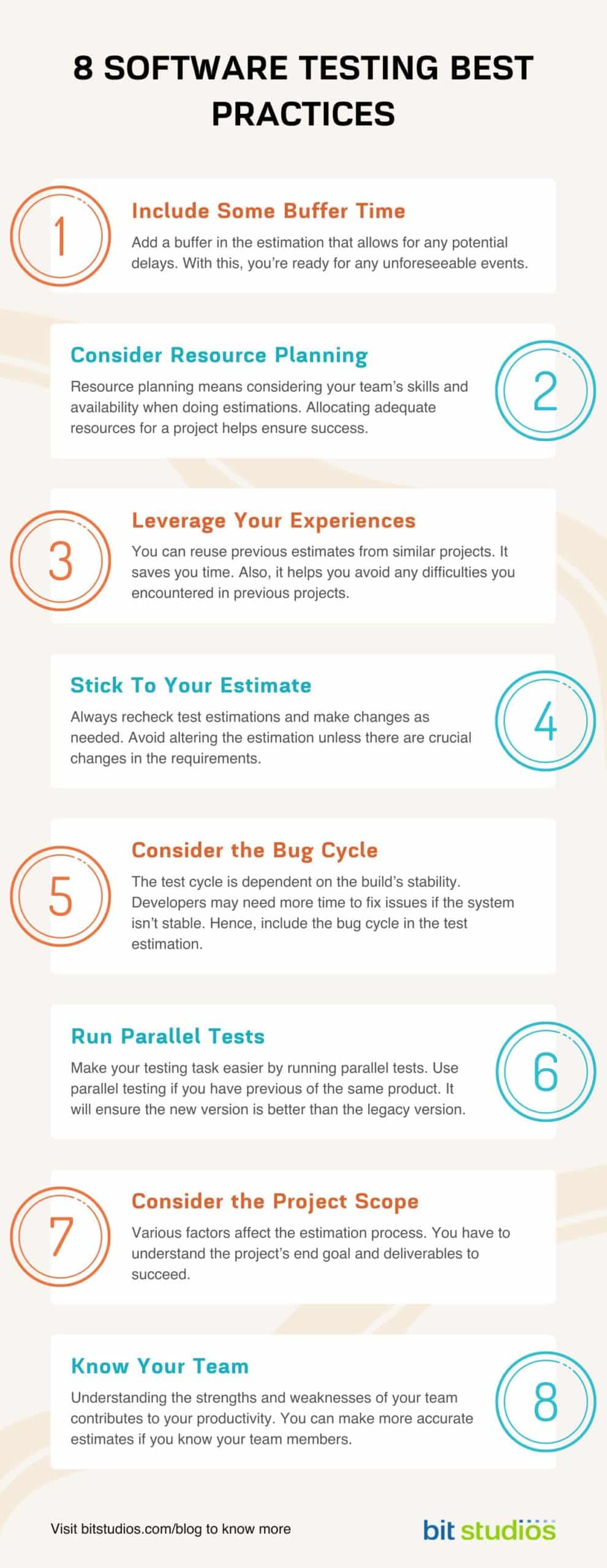Software Testing Estimation Formula
The Ultimate Guide for Beginners

Software testing estimations are an important part of the Software Development Life Cycle (SDLC). It plays a key role in test planning, project scheduling, and resource allocation by accurately estimating the effort required.
Obviously, one cannot simply enter a random number of days for any testing task. Software testing estimations should be both realistic and precise.
Different types of estimation techniques have recently emerged with increasing complexity. What are the latest estimation techniques in software testing and how do they work? Which one should you choose for your testing projects?
What Is Software Test Estimation?

Software testing estimation determines the time, cost, and testing effort needed during the testing process.
For small-scale software testing assignments, time and test effort are easy to calculate. However, larger projects can be difficult to estimate. Effective strategies must be in place to avoid mistakes. When testing resources are underestimated or overestimated, they become insufficient or misused entirely.
Test estimation includes the efforts of the project manager or engineer to complete the testing. The estimation begins with the breakdown of work using the fundamental process. This includes the identification of various stages, activities, and tasks to be completed. The following are the tasks that must be completed:
- Planning and controlling the execution of tests
- Design and analysis of scenarios
- Test implementation and execution
- Exit criteria evaluation
- Test completion and final approval
The activities for each phase are identified, and then the tasks and subtasks are defined. Following that, we estimate how long it will take to complete these tasks and subtasks.
What to Estimate in Software Testing?

When discussing potential test engagements, your clients will ask you two questions:
- How long will it take to complete the testing?
- What will it cost?
It is a forecast that assists in avoiding time constraints and budget overruns. Estimation measures these factors:
- Time
The testing team’s success is determined by its ability to meet the deadline. To determine how long it will take, we should estimate testing efforts in man-days or man-hours. Managers calculate the optimal duration for each phase of the project. Then they create a detailed schedule that ensures tasks are completed on time. This is why time estimation is important in establishing a good reputation. One effective method for estimating time is the three point estimation technique, which considers optimistic, most likely, and pessimistic scenarios to provide a more accurate average estimate.
- Resources
The testing team requires a specific set of resources to conduct a test. These resources include infrastructure, technical capabilities, specialists, time, and money. They cannot complete the task on time if there are insufficient resources. It is necessary to estimate the available assets as well as those that will need to be added.
- Cost
The estimated budget must be fully considered when preparing for any test process.
The total cost must be considered to account for potential expenditures. Estimation ensures that the project stays within the client’s budget, and works on it if it does not.
All of the fields mentioned are related and interdependent on one another. The time it will take is also determined by the tools available and the budget.
The procedure involved in software test estimation techniques has evolved over time. Various processes, methodologies, and tools have advanced with time. The tester or engineer needs to consider these changes when estimating.
- Human skills
This evaluation takes into account team members’ professional skills and experience. If they lack knowledge, the process will be slowed and the costs may go up.
As we can see, all of the aspects are intertwined and can influence one another. The time schedule is influenced by resources, human skills, and the budget. The budget, in turn, is influenced by human skills, resources, and time. And resources include both time and professional knowledge.
Why Do Estimation in Software Testing?

Understanding why test estimation is crucial helps in providing clarity and addressing client inquiries regarding project scopes.
Let’s break down some of the reasons behind software estimation’s importance:
- Estimating test costs and time is done to answer two critical questions. This is especially important for small projects with limited funds.
- Test estimation is essentially a forecast. It aids in budget management and time constraints.
- Estimation is used to predict the effort, time, and cost involved in completing the tasks. After estimating the problem scenario, the team can effectively manage the situation.
- Test estimation involves experienced people in its core decision-making. They are in charge of implementing best QA practices such as test case points, use case point methods, and so on.
Types of Estimation Techniques in Software Testing

There are many software testing estimation techniques in general. But we will only look at the popular ones:
Program Evaluation and Review Technique (PERT)
In this technique, the tasks are divided into three subcategories. These categories determine the time required for completion.
The Optimistic Scenario – O
This case assumes that the length and cost of the project are under the best conditions possible. This means that individual members of the QA Team do their best work on time. They work with no pressure, an unexpected turn of events, or the need to revisit the job.
The Most Likely Scenario – M
Everything is considered here in this scenario. It considers the typical workflow, including the negative and positive possibilities. Items are estimated as to how they are most likely to occur.
The Pessimistic Scenario – P
This is the most negative scenario possible. The estimation is based on the assumption that there will be a negative outcome to deal with at each stage.
Advantages
PERT implies that the team considers all potential hiccups and rewards on all fronts. Teams can produce an evaluation that is reasonably close to reality. It prepares organizations for any possible outcome of the build test. PERT calculates every conceivable scenario and plans adequately to mitigate it if necessary.
Disadvantages
This method of estimation won’t work when dealing with a large number of test projects. It will take much longer to complete. There is a high likelihood of incorrect calculations. The values used are never constant. They may contain many errors because they are only estimates.
Use Case Points (UCP)
The use case points (UCP) method is based on the use cases of a project.
This calculates the various variables that influence project development and complexity. These variables include:
- Actors
- Use case weights and points (adjusted and unadjusted)
- Technical complexity factors
- Environmental factors
Users or programs that interact with tested software are referred to as actors. Unadjusted use case weights are factors that influence the size of a project. According to Gustav Karner, 10 factors influence a project’s technical complexity. On the other hand, environmental complexity is affected by 8 factors.
Estimation begins with the evaluation of each variable’s complexity and project impact. The variables are then calculated using special formulas. The overall size of a project is calculated using the following formula:
UCP = UUCP x TCF x EF
- UUCP = unadjusted use case points
- TCF = technical complexity factor
- EF = environmental factor
Once a QA team has determined the size of a project, it is time to determine the duration of testing. There are two methods for estimating how long it will take. It is possible to apply Karner’s method and treat each use case as 20 person-hours. Another option is to rely on your company’s experience and estimate project duration. This is based on how long use cases typically take in your organization.
Advantages
UCP estimation can be done at the beginning of a project. It allows you to plan testing activities and approve your budget ahead of time.
Furthermore, with the help of use case management tools, the estimation can be automated. This allows an assessment team to spend less time estimating.
Disadvantages
Only projects with use case points can use the UCP method. Otherwise, the estimation team must choose another technique.
Furthermore, the UCP method’s quality results are dependent on specific use cases. The resulting estimate is likely to be inaccurate if the use cases are poorly written.
Work Breakdown Structure (WBS)

This means dividing the work into smaller modules for more accurate estimation.
Testing tasks are divided into smaller modules. Those modules are further divided into measurable sub-modules using this technique. Each sub-module is further subdivided into functionalities, which are further subdivided into sub-functionalities. The result is a very detailed hierarchical map of project functionality. These modules are estimated using any other estimation techniques to obtain actual effort.
Advantages
The WBS method ensures a precise estimate. There is less chance of missing things when a large task is divided into smaller ones. Breaking down a complex project into smaller modules results in more measurable estimates. Smaller tasks are easier to test so the estimation process is simpler. The estimation team can easily go over each task that affects project completion.
Another advantage of this technique is its clarity. WBS results are displayed in a table to ensure transparency. It also contributes to the ease of tracking progress.
Disadvantages
The WBS technique requires a lot of knowledge because it is resource-intensive. As a result, a WBS assessment includes all stakeholders.
WBS estimates may also become out of date over time as project requirements change. If a client changes some functionality, the team must re-estimate parts of the project.
Delphi Technique

his is one of the most widely used testing estimation techniques. A panel of experts discusses the given task and makes anonymous personal forecasts. The panel is guided by a test manager and explains their reasoning.
After the first round, the range of answers is usually quite broad. The experts then revise their answers based on the opinions of other members. Several rounds may be conducted until the range of answers narrows. After that, the team calculates the average value. The procedure is completed when a predefined criterion has been met.
The Delphi technique is very simple and quite reliable. It produces both qualitative and quantitative results.
Advantages
Wideband Delphi estimation is simple to perform. Once a QA team has received the customer’s requirements, the project can be evaluated. Furthermore, such estimation does not necessitate any special preparation or tools.
Disadvantages
It takes time to apply this technique. During the first round, it can be difficult to come up with a single estimate. As a result, such an evaluation may necessitate 2, 3, or even more rounds.
Furthermore, the results of such an estimate cannot be reused. It is difficult to document the assessment process so it can’t be used as a basis for future estimates. This estimation technique cannot be applied to other (even similar) projects. Every time it is used, it must be done from the ground up.
Experience-Based

The idea behind this method is to estimate a project using the experience of a QA team. A team may have already tested a similar project, in which case it can be used as a basis for estimation. The experience-based approach is divided into two parts: analogous and expert judgment.
Analogous estimation takes the estimate of a previous product and creates a new one based on it. If there are new requirements, they are evaluated using the experience of the expert.
Advantages
A mature quality assurance team can provide a precise estimate using this approach. Once a team has completed dozens of projects, they are confident in their estimates.
The expert-based technique uses existing estimates and documents from previous projects. Using these as a basis for the estimate leads to quicker results.
Disadvantages
This experience-based approach is difficult to apply to unique projects. This is because estimating new features that a QA team may encounter takes more time and effort.
Furthermore, this technique is not appropriate for young teams because they lack experience.
Function Points (FP)

Function point analysis measures the project size and influence project duration. It is possible to determine the size of a project if a QA team is aware of the following variables:
- Unadjusted function point
- Total degree influence
- Value adjustment factor
After calculating all of the variables, the team uses the following formula. This Function Point Analysis formula determines the adjusted function point that equals the project size:
Adjusted FPC = Non-adjusted FPC x VAF
FPC means functional point count and VAF stands for value adjustment factor.
Before performing the estimate, the QA team decides on the type of count, its scope, and its boundaries.
Advantages
There are no restrictions on how project requirements can be expressed. This means that the function point technique can be used to estimate the size of any project.
The results of function point estimation are easily understood even by the clients.
Disadvantages
Estimating a testing project using this technique takes a long time. This is because the estimate must take into account many variables.
Furthermore, estimating function points is difficult. The team must analyze a large amount of input data and produce a large amount of documentation.
Percentage Distribution

When using this technique, the software development life cycle is divided into stages. Each stage is evaluated as a percentage of the total time required for the project.
The entire scope of testing tasks is also distributed across 100% of the total testing time. The QA team determines how much of their testing time should be spent on each stage of testing. Then, the team expresses this time as a percentage.
Advantages
This technique is simple to use. It does not need any specific tools or requirements. All that is required is a team with sufficient expertise to estimate a testing project.
Disadvantages
This assessment should be performed by highly experienced experts to get accurate results. In one company, it may be difficult to find all of the experts who could be useful in estimating a project. Results may be inaccurate. This is because software testing estimation is performed without specific requirements.
Agile Estimation

The techniques described above are better suited for Waterfall development and V-model development. They take a “bottom-up” approach in which all details and requirements are defined. All tasks are estimated separately before planning the project schedule and budget. However, these estimation approaches have significant drawbacks. As a result, the number of tasks that use these methodologies is currently decreasing.
Customers and providers are increasingly preferring agile development methodology. It emphasizes continuous delivery, makes the process user-focused, and provides a competitive advantage. Agile estimation differs from traditional techniques in that it takes a “top-down” approach.
It means that you process currently available data and provide a higher-level estimate. As the project progresses, new information is revealed and incorporated into the estimation. The values are then refined and improved while the development process continues. This approach enables the team to effectively estimate new features.
Advantages
An Agile estimation approach emphasizes innovation and creativity. The shorter startup time results in faster opportunities to advertise. Another advantage of Agile estimation is that it can reduce a project’s costs. It significantly lowers overhead by reducing unnecessary documentation and control requirements.
Disadvantages
To execute effectively, Agile needs preparation and expertise. Many teams either do not understand or do not want to invest in Agile, hence the errors. To be effective, an Agile approach may also need some degree of hierarchical change.
Factors to Consider When Choosing a Technique
When selecting a software test estimation technique, several factors should be considered to ensure the chosen method is suitable for the project. These factors include:
- Project Complexity: The technique should be able to handle the complexity of the project, including the number of features, functionalities, and integrations. Complex projects may require more sophisticated estimation techniques to account for various dependencies and interactions.
- Project Size: The technique should be scalable to accommodate the size of the project, including the number of team members, resources, and timelines. Larger projects often involve more variables, making it essential to choose an estimation technique that can manage this scale effectively.
- Team Experience: The technique should be suitable for the experience level of the team, including their familiarity with the technology, domain, and testing processes. Experienced teams might prefer techniques that leverage their expertise, while less experienced teams might benefit from more structured approaches.
- Time Constraints: The technique should be able to provide accurate estimates within the given time constraints, including the project timeline and deadlines. Some techniques are quicker to implement but may be less detailed, while others are more thorough but time-consuming.
- Resource Availability: The technique should take into account the availability of resources, including personnel, equipment, and infrastructure. Limited resources might necessitate simpler estimation methods, whereas abundant resources could allow for more comprehensive techniques.
- Risk Management: The technique should be able to identify and mitigate potential risks, including technical, schedule, and budget risks. Effective risk management is crucial for ensuring that estimates remain realistic and achievable.
- Stakeholder Expectations: The technique should be able to meet the expectations of stakeholders, including clients, project managers, and team members. Clear communication and alignment with stakeholder goals are essential for successful project delivery.
By considering these factors, project managers and teams can choose a software test estimation technique that is tailored to their specific needs. This ensures accurate estimates, effective resource allocation, and successful project delivery.
Common Challenges in Software Testing Estimation
Software testing estimation is a complex process that can be prone to challenges and errors. Some common challenges include:
- Inaccurate Estimates: Inaccurate estimates can lead to project delays, cost overruns, and resource misallocation. Ensuring precision in estimates is crucial for maintaining project timelines and budgets.
- Insufficient Data: Insufficient data can make it difficult to create accurate estimates, leading to project risks and uncertainties. Gathering comprehensive data from the outset can help mitigate this issue.
- Complexity: Complex projects can be difficult to estimate, requiring specialized techniques and expertise. Breaking down complex tasks into smaller, manageable parts can aid in more accurate estimation.
- Team Dynamics: Team dynamics, including communication, collaboration, and experience, can impact the accuracy of estimates. Fostering a collaborative environment and leveraging team strengths can improve estimation accuracy.
- Scope Creep: Scope creep can lead to changes in project requirements, impacting estimates and project timelines. Clearly defining project scope and managing changes effectively can help control this challenge.
- Resource Constraints: Resource constraints, including personnel, equipment, and infrastructure, can impact the accuracy of estimates. Planning for resource availability and potential shortages is essential for realistic estimates.
- Stakeholder Expectations: Stakeholder expectations, including client expectations and project manager expectations, can impact the accuracy of estimates. Regular communication and setting realistic expectations can help align all parties involved.
To overcome these challenges, project managers and teams should use a combination of estimation techniques, leverage historical data, and engage in continuous communication and collaboration. This approach helps in creating more accurate and reliable estimates, ultimately leading to successful project outcomes.
Software Testing Estimation Best Practices

Software testing estimation can be a tedious process. But there are several things you can do to ensure the success of the test team. Here are some of them:
1. Include some buffer time.
Many unforeseeable events may occur in your project. For instance, a talented team member may abruptly leave his job. There are also instances when the testing takes longer than expected, and so on. That is why you should include a buffer in your estimation. Including a buffer in the estimation allows for any delays that may occur.
2. Consider resource planning in estimation.
What should you do if some of your team members take extended leave? It may cause the project to be delayed. In estimation, resource planning is critical. The availability of resources will aid in ensuring that the estimates are accurate. You must consider the leaves for your team member, which should be long.
3. Leverage your experiences.
Time estimates are greatly influenced by previous project experiences. Because some projects may be similar, you can reuse previous estimates. For example, if you used to work on a project like a website testing, you can learn from that experience. Try to avoid all the difficulties that you encountered in previous projects.
4. Stick to your estimate.
Estimation is only an estimate because it is subject to error. In the early stages, you should always re-check the test estimations. Make changes as needed according to your estimations. Do not extend the estimation unless there are significant changes in the requirements.
5. Consider the bug cycle.
The bug cycle is also included in the test estimation. The actual test cycle may take longer than expected.
To avoid this, keep in mind that the test cycle is dependent on the build’s stability. If the build is not stable, developers may need more time to fix it. Hence, the testing cycle will be automatically extended.
6. Run parallel tests.
Do you have any previous versions of the same product to compare the results? If so, this may make your testing task a little easier. You should consider the estimation based on the version of your product.
7. Consider the project scope.
Understand the project’s end goal and a list of all final deliverables. The factors to consider for small and large projects are vastly different. Large projects include setting up the testbed, test data generation, and so on.
As a result, estimations should be based on all of these factors. For small projects, the test cycle includes test case creation, execution, and regression.
8. Know your team.
You can estimate more precisely if you know the strengths and weaknesses of your team. Keep in mind that not all resources will produce the same level of productivity.
When compared to others, some people can execute faster. Though not a major factor, it contributes to the overall delay in deliverables.
Tools and Resources for Software Test Estimation
Several tools and resources are available to support software test estimation, including:
- Estimation Templates: Estimation templates, such as Excel templates, can provide a structured approach to estimation. These templates help standardize the estimation process and ensure consistency across projects.
- Project Management Tools: Project management tools, such as Jira, Trello, and Asana, can support estimation, resource allocation, and project tracking. These tools offer features that help manage tasks, timelines, and team collaboration effectively.
- Testing Tools: Testing tools, such as Selenium, Appium, and TestComplete, can support testing efforts and provide data for estimation. These tools automate various testing tasks, making it easier to gather accurate data for estimation.
- Historical Data: Historical data, including data from previous projects, can provide insights into estimation accuracy and support future estimation efforts. Analyzing past projects helps identify patterns and improve estimation techniques.
- Estimation Software: Estimation software, such as Estimation Studio, can provide advanced estimation capabilities, including machine learning and predictive analytics. These tools offer sophisticated features that enhance the accuracy and efficiency of the estimation process.
- Online Resources: Online resources, including blogs, articles, and webinars, can provide guidance on estimation techniques, best practices, and industry trends. Staying updated with the latest information helps refine estimation skills and knowledge.
- Training and Certification: Training and certification programs, such as ISTQB and CSTE, can provide education and certification in software testing and estimation. These programs enhance the skills and credibility of team members, leading to more accurate estimates.
By leveraging these tools and resources, project managers and teams can improve the accuracy of their estimates, reduce project risks, and deliver successful projects. Utilizing a combination of these resources ensures a comprehensive approach to software test estimation, ultimately contributing to project success.
Conclusion
Today’s software ecosystem focuses on reducing time to market and increasing customer demands. Hence, accurate estimation techniques, including software automated testing services, are critical to project success. Without accurate estimates, projects will either fail or go over budget, leaving your clients unhappy. It is also crucial to determine which type of estimate is best suited for a specific project.
In some cases, more than one technique or a combination of techniques, such as software automated testing services, may be required. If the variation between techniques is small, it provides assurance of accurate estimates.
The key here is to find the right software estimation team that specializes in automated software testing services. You want a team that would provide an accurate software testing estimation on time and on budget. BIT Studios does just that.
We’re BIT Studios!
At BIT Studios we specialize in designing, building, shipping, and scaling beautiful, usable products with blazing-fast efficiency



